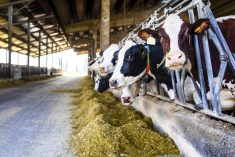The federal government wants a 30 per cent reduction in emissions from fertilizer, but says it is voluntary
The Wheat Growers Association says claims that the federal government is threatening to force a 30 per cent reduction in nitrogen fertilizer use, published in a newsletter aimed at consumers, was meant to prove a point.
“We aren’t really exaggerating,” said Wheat Growers president Gunter Jochum. “I felt they were not exaggerating because of the government’s track record.”
In the emailed newsletter, which Jochum said was meant to build public awareness, the Wheat Growers said, “the target of an absolute reduction in the nutrients used to produce our food was done without the consultation of the fertilizer industry or Canadian grain farmers.”
Read Also

Grazing ‘sweet spot’ boosts pasture performance
Timing-focused approach to pasture management touted to boost forage growth, livestock gains while also cutting farmer labour and inputs
It also took aim at the carbon tax, saying it hurts farmers at every stage of production and makes food more expensive.
“If fertilizer is reduced while input costs are rising, farmers will produce less. Much less. That will increase the cost of food,” it says.
The newsletter urged respondents to sign a petition or contribute financially to the organization.
Emission reduction targets
The federal government has not announced a mandated reduction in use of nitrogen fertilizer.
“You could make the case, well, that’s not really what the government said,” Jochum acknowledged. “However, they also said … a few years ago that they would not raise the carbon tax but here we are.”
In late 2020, the government announced a national target to reduce emissions from fertilizer by 30 per cent below 2020 levels by 2030. The announcement caused consternation among many in the ag sector who considered it a de facto limit on fertilizer or worried that it would eventually become mandatory.
The government emphasized the voluntary nature of the target. Then-agriculture minister Marie-Claude Bibeau said it would rely on incentives rather than punitive measures.
“We need to ensure that our efforts to reduce emissions do not undermine [farmer] competitiveness or their vital work, especially at a time when food insecurity has reached unprecedented levels worldwide and the fertilizer supply chain is increasingly strained,” she said as part of a report published by Agriculture and Agri-Food Canada earlier this year.
“I would like to be clear; there is no mandatory reduction in fertilizer use on Canadian farms,” she also said at the time. “Instead, we want to support measures that producers can take voluntarily to reduce their emissions over the long term without curtailing growth in crop yields.”
Skeptical
Jochum is unconvinced.
“We want to hit home what potentially could happen,” he said.
He said the government is listening to special interest groups who can’t prove what emissions come from nitrogen fertilizer, and the result is a burden on farmers. He said his organization felt that perspective should be told to consumers.
Will farmers be forced to cut?
A mandated cut in fertilizer use doesn’t seem likely, said Mario Tenuta, senior industrial research chair in 4R nutrient management at the University of Manitoba.
“I don’t see a mandated 30 per cent reduction in fertilizer nitrogen use to be anything that is going to be of benefit,” he said, while emphasizing that he’s a researcher, not a policy maker.
Grain exports are critical to the Canadian economy and rural communities and the government knows this, said Tenuta. It also knows that forcing farmers to reduce fertilizer use would cause further alienation and that is a poor political strategy.
Tactics like financial incentives, extension, demonstration and research are more likely, he added.
The On-Farm Climate Action Fund (OFCAF), which subsidizes farmers to try new management practices to reduce emissions, may evolve to include new practices and clarify current ones, said Tenuta. The federal government pledged $200 million to the fund, which is administered by producer groups and local governments.
That said, he understands the need for agriculture groups to keep pressure on governments to move in the direction they want.
Challenges
Whether a 30 per cent reduction in emissions can be achieved without cutting application has been hotly debated. In 2022, Fertilizer Canada said emissions could be reduced 14 per cent by 2030 without jeopardizing food security if “aggressive, but attainable” best management practices were implemented.
In 2018, the industry group released research indicating that “while nitrous oxide emission reduction is based on climate and soil, the flexibility of the 4R Nutrient Stewardship framework allows growers from any region to maximize the results of their nutrient management practices, thus achieving a reduction rate of up to 35 per cent.”
That’s according to David Burton, a nitrous oxide researcher from Dalhousie University, quoted in a 2018 news release.
Tenuta has said 30 per cent could be conservative.
“Our research shows we could easily do way more than that in terms of reduction without reducing productivity,” he told Glacier FarmMedia in 2022.
However, significant cash on the table is necessary, said Manish Raizada, a researcher from the University of Guelph. He said the Liberal government hasn’t equipped farmers to reduce emissions and now expects a quick turnaround.
A version of this article originally appeared in the Manitoba Co-operator.
















